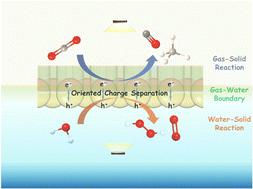当前位置:
X-MOL 学术
›
Energy Environ. Sci.
›
论文详情
Our official English website, www.x-mol.net, welcomes your feedback! (Note: you will need to create a separate account there.)
A floatable photocatalyst to synergistically promote CO2 reduction and water oxidation by creating oriented charge separation across a tri-phase interface
Energy & Environmental Science ( IF 32.4 ) Pub Date : 2024-05-29 , DOI: 10.1039/d4ee00800f Yangen Xie 1, 2 , Min Wang 3 , Qiang Huang 1, 2 , Qing Huang 1, 2 , Bo Sheng 1, 2 , Wenjing Song 1, 2 , Hua Sheng 1, 2 , Jincai Zhao 1, 2
Energy & Environmental Science ( IF 32.4 ) Pub Date : 2024-05-29 , DOI: 10.1039/d4ee00800f Yangen Xie 1, 2 , Min Wang 3 , Qiang Huang 1, 2 , Qing Huang 1, 2 , Bo Sheng 1, 2 , Wenjing Song 1, 2 , Hua Sheng 1, 2 , Jincai Zhao 1, 2
Affiliation

|
Artificial photosynthesis, which combines photocatalytic CO2 reduction with water oxidation to produce carbon-based fuels and feedstocks, has gained extensive interest nowadays. To optimize this system, a synergistic promotion of CO2 reduction and water oxidation is required. However, an obstacle to achieving this synergy is the contradiction in the preferred reaction environments between CO2 reduction (preferring a gas–solid environment) and water oxidation (preferring a water–solid environment). To address this challenge, we have developed a floatable catalyst by sequentially layering Cu2O, Ag and TiO2 on a PTFE membrane support. When this catalyst floats on the gas–water boundary and is illuminated, oriented charge separation occurs across the membrane and the tri-phase (gas–water–solid) interface. Photogenerated electrons accumulate on the side of the membrane exposed to the gas phase, initiating gas–solid CO2 reduction. Simultaneously, holes transfer to the side immersed in water, facilitating water–solid water oxidation. This design enhances the production rate by 120 fold and 10 fold for CO2 reduction and water oxidation to H2O2 at most, and selectivity by up to 105 times and 2 times for these two half-reactions at most, when compared to a conventional gas–solid or water–solid system, or a tri-phase system on a catalyst without oriented charge separation. Distinctive to the generally considered catalyst-centered strategies, this study provides a new insight to optimize photocatalysis through the regulation of the reaction environment.
中文翻译:

一种可漂浮的光催化剂,通过在三相界面上产生定向电荷分离,协同促进二氧化碳还原和水氧化
人工光合作用将光催化 CO 2 还原与水氧化相结合来生产碳基燃料和原料,目前已引起广泛关注。为了优化该系统,需要协同促进 CO 2 还原和水氧化。然而,实现这种协同作用的一个障碍是CO 2 还原(优选气固环境)和水氧化(优选水固环境)之间的优选反应环境之间的矛盾。为了应对这一挑战,我们通过在 PTFE 膜载体上顺序分层 Cu 2 O、Ag 和 TiO 2 开发了一种可漂浮催化剂。当该催化剂漂浮在气-水边界上并被照射时,跨膜和三相(气-水-固)界面发生定向电荷分离。光生电子积聚在暴露于气相的膜一侧,引发气固 CO 2 还原。同时,空穴转移到浸入水中的一侧,促进水-固水氧化。该设计将 CO 2 还原和水氧化为 H 2 O 2 的产率最多提高了 120 倍和 10 倍,选择性高达与传统的气-固或水-固体系或没有定向电荷分离的催化剂上的三相体系相比,这两个半反应最多分别为105倍和2倍。与通常认为的以催化剂为中心的策略不同,这项研究提供了通过调节反应环境来优化光催化的新见解。
更新日期:2024-05-29
中文翻译:

一种可漂浮的光催化剂,通过在三相界面上产生定向电荷分离,协同促进二氧化碳还原和水氧化
人工光合作用将光催化 CO 2 还原与水氧化相结合来生产碳基燃料和原料,目前已引起广泛关注。为了优化该系统,需要协同促进 CO 2 还原和水氧化。然而,实现这种协同作用的一个障碍是CO 2 还原(优选气固环境)和水氧化(优选水固环境)之间的优选反应环境之间的矛盾。为了应对这一挑战,我们通过在 PTFE 膜载体上顺序分层 Cu 2 O、Ag 和 TiO 2 开发了一种可漂浮催化剂。当该催化剂漂浮在气-水边界上并被照射时,跨膜和三相(气-水-固)界面发生定向电荷分离。光生电子积聚在暴露于气相的膜一侧,引发气固 CO 2 还原。同时,空穴转移到浸入水中的一侧,促进水-固水氧化。该设计将 CO 2 还原和水氧化为 H 2 O 2 的产率最多提高了 120 倍和 10 倍,选择性高达与传统的气-固或水-固体系或没有定向电荷分离的催化剂上的三相体系相比,这两个半反应最多分别为105倍和2倍。与通常认为的以催化剂为中心的策略不同,这项研究提供了通过调节反应环境来优化光催化的新见解。






































 京公网安备 11010802027423号
京公网安备 11010802027423号